BLOG
Demographic Segmentation Defined with 5 Marketing Examples
Published: Jul 31, 2020
Learn how to effectively use demographic segmentation in your eCommerce marketing strategy. Get inspired by real-world examples from household brands.
If you want an effective way to target your marketing, customer segmentation is an excellent entry point. Segmentation groups customers based on different factors and allows you to apply messaging that speaks directly to their needs.
There are 4 main types of market segmentation: demographic, psychographic, geographic, and behavioral. Each provides different ways to look at your customer base, and define what it is that will help you sell to them.

In this blog post, we’re going to do a deep-dive into demographic segmentation, and see how generic non-character traits like age, religion, or level of education can help guide your eCommerce marketing strategy. Let’s begin!
What is demographic segmentation?
Definition: Demographic segmentation groups customers and potential customers together by focusing on certain traits such as age, gender, income, occupation & family status.
It’s an accessible form of market segmentation, as it requires fewer data points to implement than psychographic or behavioral segmentation, whilst offering more selective nuance than geographic segmentation. There are plenty of ways to segment markets using demographics.
The most commonly used demographic segmentation factors are:
- Age
- Gender
- Ethnicity
- Income
- Level of education
- Religion
- Occupation
- Family structure
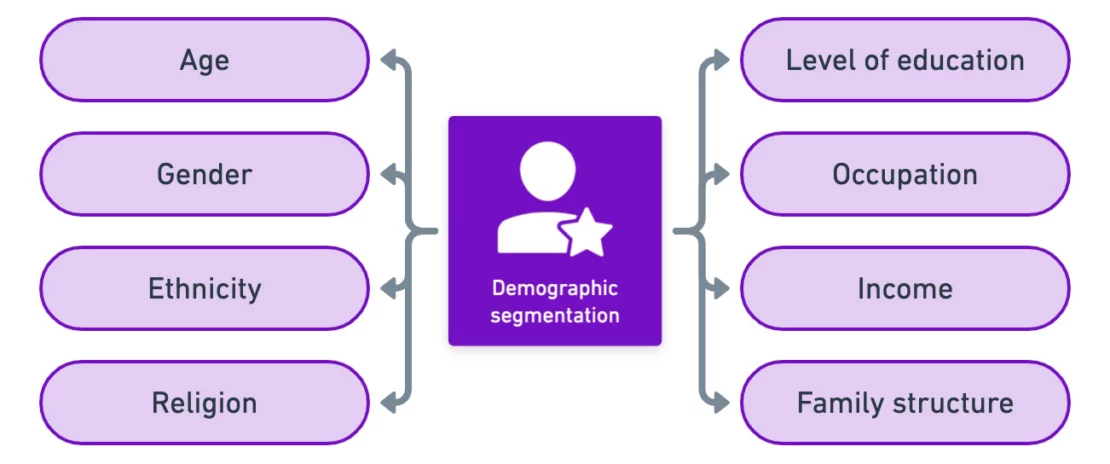
The simplest way to adopt demographic segmentation is by using factors like age gender income, but there are many non-character traits that you can focus on. Income and family structure are particularly useful factors for retailers, allowing them to single out certain groups that might be interested in purchasing a specific product or service.
Business-to-business (B2B) marketers, however, are much more likely to rely on occupational segmentation to ensure they are pitching their products to the people who actually make purchases for their company, and not an intern who has no purchasing power.

Segmentation vs. targeting – what’s the difference?
It’s important to recognize that segmentation and targeting differ, though they can be closely linked.
Market segmentation isn’t about targeting specific customers, but about creating groups based on the different traits that they share. Demographic segmentation allows you to collate your customers in a way that then lets you identify the best way to promote your goods or services to them.
Once you’ve segmented your market, you might look to target a segment – targeting itself is the action of looking at an already defined market segment and asking yourself how you can reach them specifically.
One way to better explain how segmentation and targeting are different but work together is via the STP marketing model.
STP (Segmentation, Targeting, Positioning) is a three-step approach that combines each of the above practices to hone in and successfully market to consumers.
- First, we segment the audience using market segmentation practices.
- Next, we choose which of those segments to target.
- Finally, we use this information to guide our positioning and identify the most effective marketing mix to reach the audience we want to focus on.
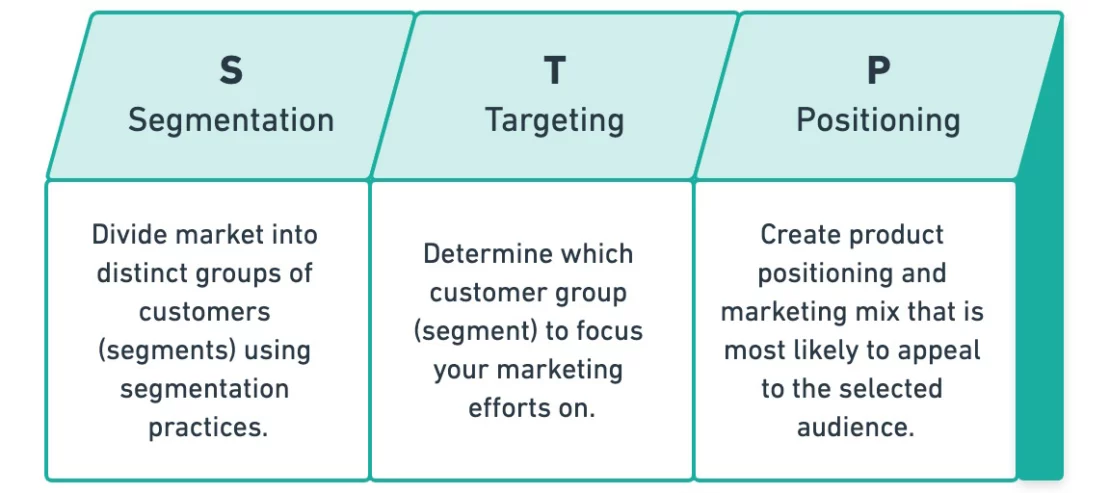
What that could look like in real life is a hypothetical food company that uses demographic data to segments its market by age group. Looking at sales across these segments, they might acknowledge that 25-30 year-olds are not buying as many yogurts as older segments. So they would look to target their marketing campaigns towards the 25-30-year-old group in order to change this.
Having chosen this demographic segment as its target, the company can start working on its positioning to make it youthful and its marketing mix to reach the target market via channels they use most.
Demographic segmentation benefits
If you use demographic segmentation as part of your marketing strategy, you’ll benefit from the following:
1. Improved personalization. A segmented market allows you to present different messaging to different demographic segments. The same product can be shown in different ways – for instance, a car might be marketed as a family-friendly vehicle to parents, whilst couples who don’t have children are shown other benefits, like its suitability for long driving holidays. So your marketing strategies should resonate a lot better.
2. Improved product relevance. As a result of this, you can ensure people seeing your marketing are presented with products more relevant to them. Demographic marketing is particularly useful for advertising kosher or halal products to the right audience. An advert showing a non-halal meat product to a Muslim could risk isolating the customer and putting them off making future purchases from you.
3. Improved advertising effectiveness. To take the above example further, you’ve also wasted your marketing budget in advertising that non-halal product to a Muslim, as they are never going to be a buying customer. Demographic segmentation allows you to target the most relevant customers, and ensure that there is minimal waste in your advertising budget, higher ROAS, and lower CACs.

Is demographic segmentation right for me?
The short answer is: it depends. Demographic segmentation is not always the most effective type of segmentation to use. It’s important to look at what you are selling, the size of your business, and who you are selling to. It might be that there are other strategies that would work better.
If you are an online clothes retailer you might want to consider if you have enough data to implement behavioral marketing, which potentially offers even more personalization opportunities.
A company that only has the infrastructure to service a local area might be better served using geographic segmentation, and one that sells hobby-centric products like c
Disadvantages of Demographic Segmentation
As highlighted above using demographic segmentation may not be the right move for everyone. As you’re only focusing on basic data that excludes actual customer behaviours and desires its effectiveness is limited.
Limited Range
For example, just because we have two people in the same demographic segment doesn’t mean they want the same things.
Using the wrong demographic variables
In some cases, it won’t make sense to use every demographic variable there is. So don’t. For example, if you’re selling high-end luxury products segmenting your market by income makes sense. If you’re selling food, segmenting by Gender may not be the most useful variable to use.
Demographics will always play an important role in identifying your target customer but it’s vital to combine demographics with other types of market segmentation to get the complete view.
Examples Of Demographic Segmentation In Marketing
Because there is such a wide variety of demographics that you can use to segment your market, there’s also a wealth of options for utilizing the strategy. Let’s look at some demographic segmentation examples in action.
Segmenting based on age
Whilst it isn’t a universal truth, it’s fair to say that people of different ages often have very different desires and Whilst it isn’t a universal truth, it’s fair to say that people of different ages often have very different desires and expectations. Taking this into account as you plan your marketing strategy can be a useful tool.
Age segmentation example
Saga Holidays sell travel packages exclusively to those over 50, and their marketing reflects this.
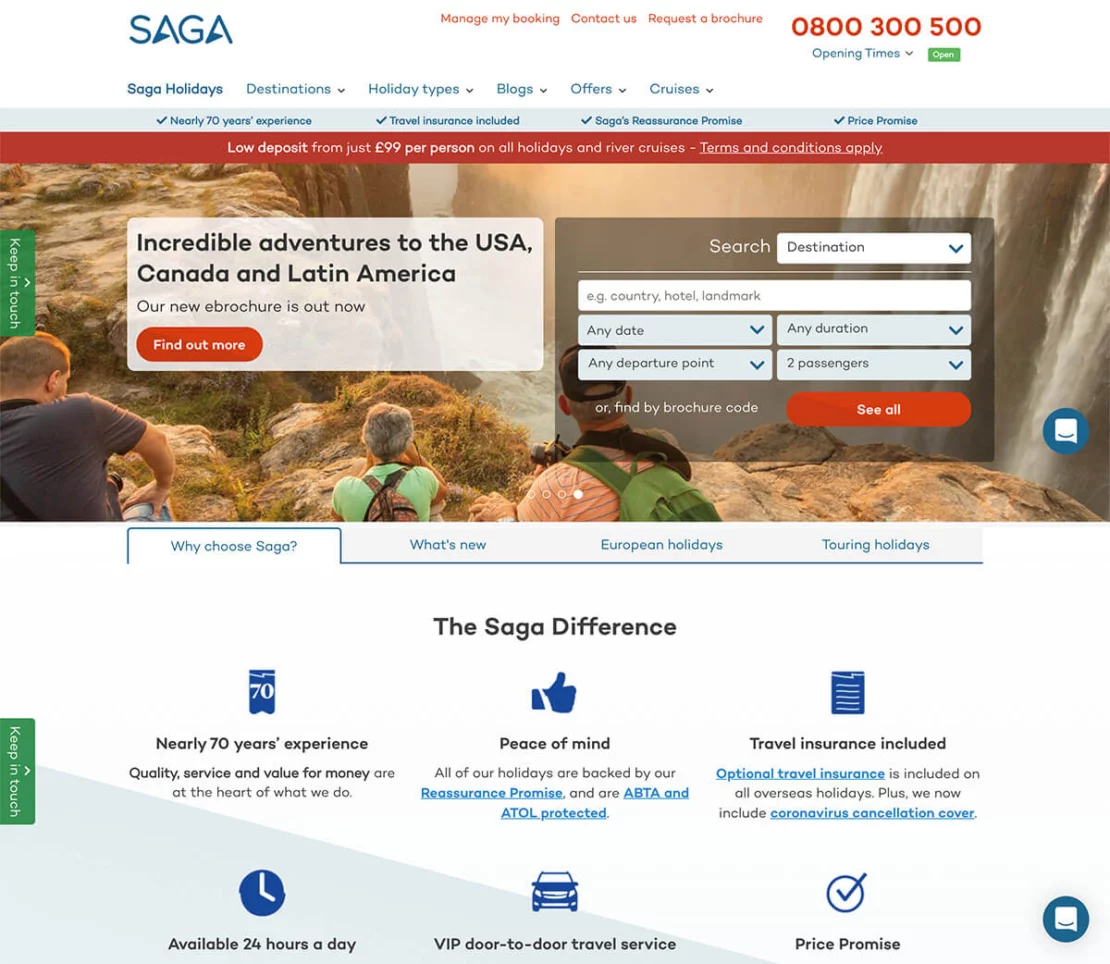
The images they use to show their holidays are serene and peaceful, the people represented in the lifestyle shots are well in the target audience’s age range, and the company goes out of its way to highlight the USPs important to their age segment: airport pick up, door-to-door travel service, insurance, etc.
This won’t necessarily appeal to all over 50 year-olds, but those who are still looking for busy, exciting adventures are not Saga’s target market anyway, so using demographic segmentation in marketing this way makes a lot of sense.
Segmenting based on gender
Gender-specific marketing can be a very powerful tool when done well, but it’s increasingly important to consider your messaging.
Pen manufacturers Bic have twice been called out for using lazy stereotypes to sell to women: first by producing a Bic for Her that was nothing more than a pink pen; and second with an International Women’s Day campaign that told women to “Look like a girl, act like a lady, think like a man, work like a boss.”
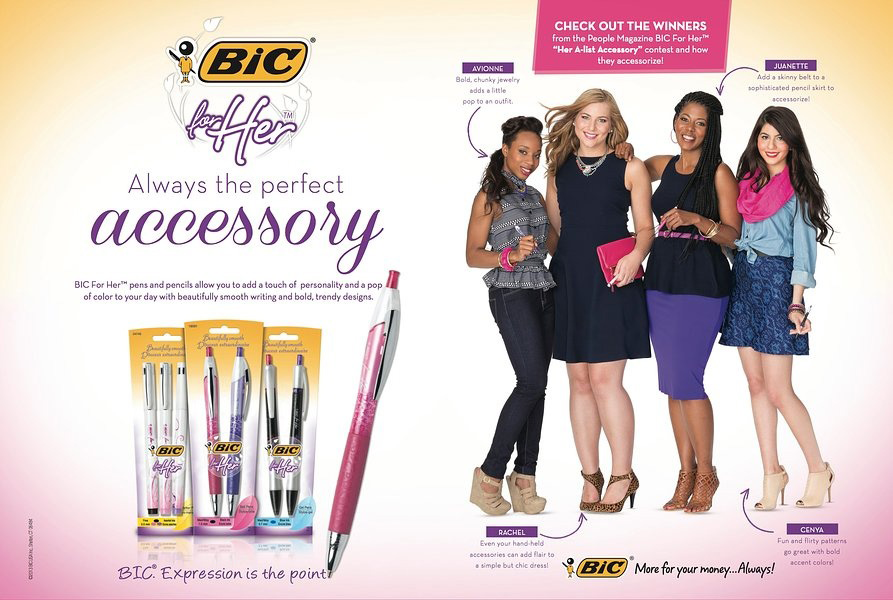
Effective gender marketing isn’t about playing up gender stereotypes, but about presenting clear, effective, and taEffective gender marketing isn’t about playing up gender stereotypes, but about presenting clear, effective, and targeted marketing.
An excellent example of this is our client War Paint for Men, a men’s make-up brand that provides clear and effective marketing towards their chosen market segment: from the brand name to the imagery to the content, their message is crystal clear.

Segmenting based on income & occupation
A very useful marketing tool is to segment by occupation or related demographics, such as income bracket or the level of education the person has reached.
Students are the frequent target of marketers, as a segment who are easily defined and have unique interests and needs. Perhaps the most common of these strategies is income-related segmentation.
Marketers find this tool useful as people in different income brackets can have drastically different approaches to making purchases. Crudely speaking, those in lower brackets are more likely to be swayed by good value, whereas those with more disposable income will be happier to spend more for a better product.
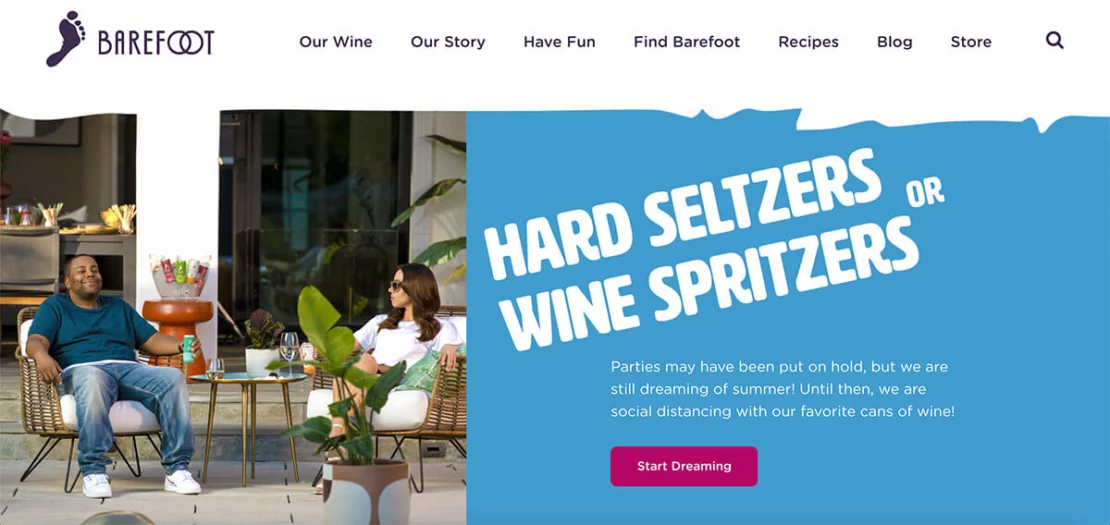
Compare the bright and casual tone that mass-market wine brand Barefoot uses, above, with that of the luxury sparkling wine brand Nyetimber, below.
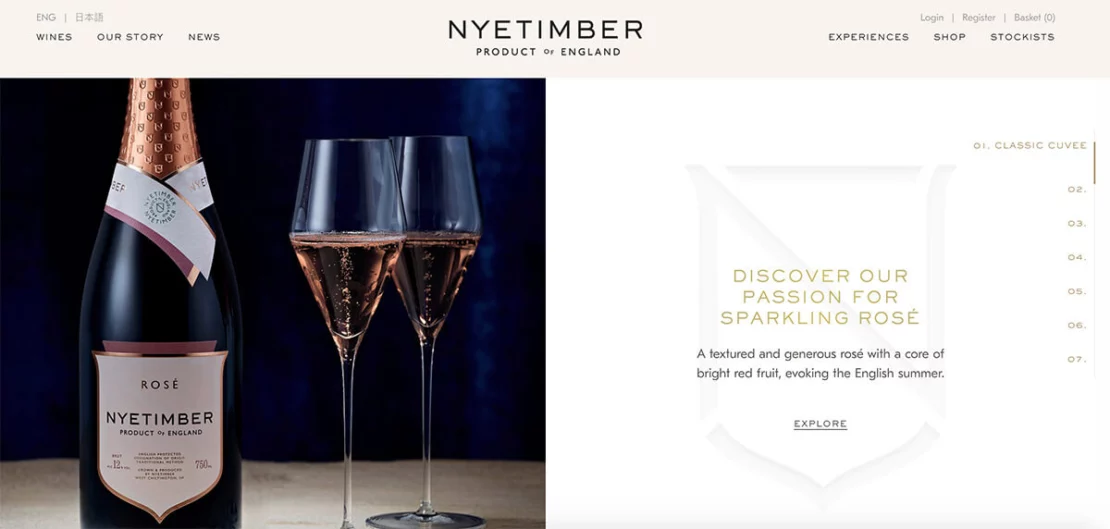
Segmenting based on cultural background
Demographic segmentation also allows us to group our customers by ethnicity, religion, and nationality. This is perhaps most useful for those in the food sector, particularly for businesses selling food or products from specific cuisines.
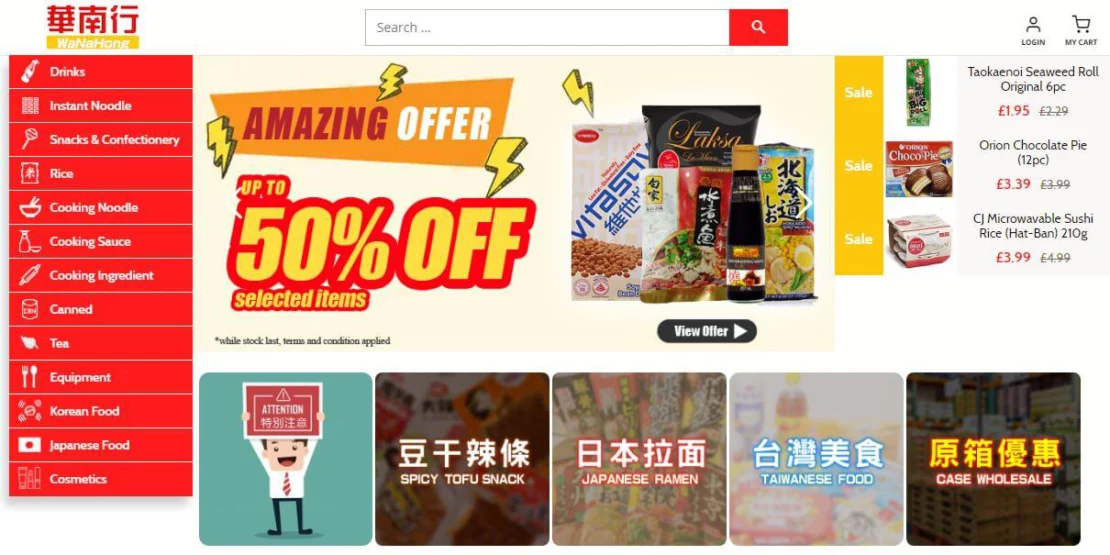
WaNaHong is an online Asian supermarket selling primarily to Asian expats living in the UK. Their website features many familiar products from China, Japan, Taiwan, and other Asian nations, and is also skewed heavily towards providing the best experience for their customers, with many headings and products described in both Chinese and English.
Their COVID-19 information page was presented in Chinese first to ensure maximum clarity for their customers.
Segmenting based on family status
We can find our final group of demographic traits in the home – looking at marital statuses, family structure (for instance, how many children a family has), and the life stages of those in each family.
This could include things like how far each child is into their education, whether the person is renting their home or owns it and, in the case of the latter, whether or not they have paid their mortgage off.

Department store Kohl’s presented brilliantly conceived Back to School marketing campaign during the COVID-19 pandemic that both spoke to parents’ needs to buy equipment for the new school year, but also acknowledged the very specific and unique situation they were facing – highlighting that children might be heading back to school, but might also just be logging on for remote learning at home.
Either way, they present themselves as a solution and allow for those in this particular life stage to feel catered for.
In conclusion
Demographic segmentation is an excellent ecommerce conversion rate optimization strategy to provide relevant and targeted messaging to potential and existing customers. The key for your business is identifying which demographic segments are most relevant to you, and how best to utilize the opportunities segmentation affords you.
Demographic segmentation FAQ:
Demographic segmentation groups customers and potential customers together by focusing on certain traits that might represent useful markets for a business.
The five main demographic segments are age, gender, occupation, cultural background, and family status.
An example of segmenting by age would be Saga Holidays. They sell travel packages exclusively to those over 50, and their marketing reflects this.